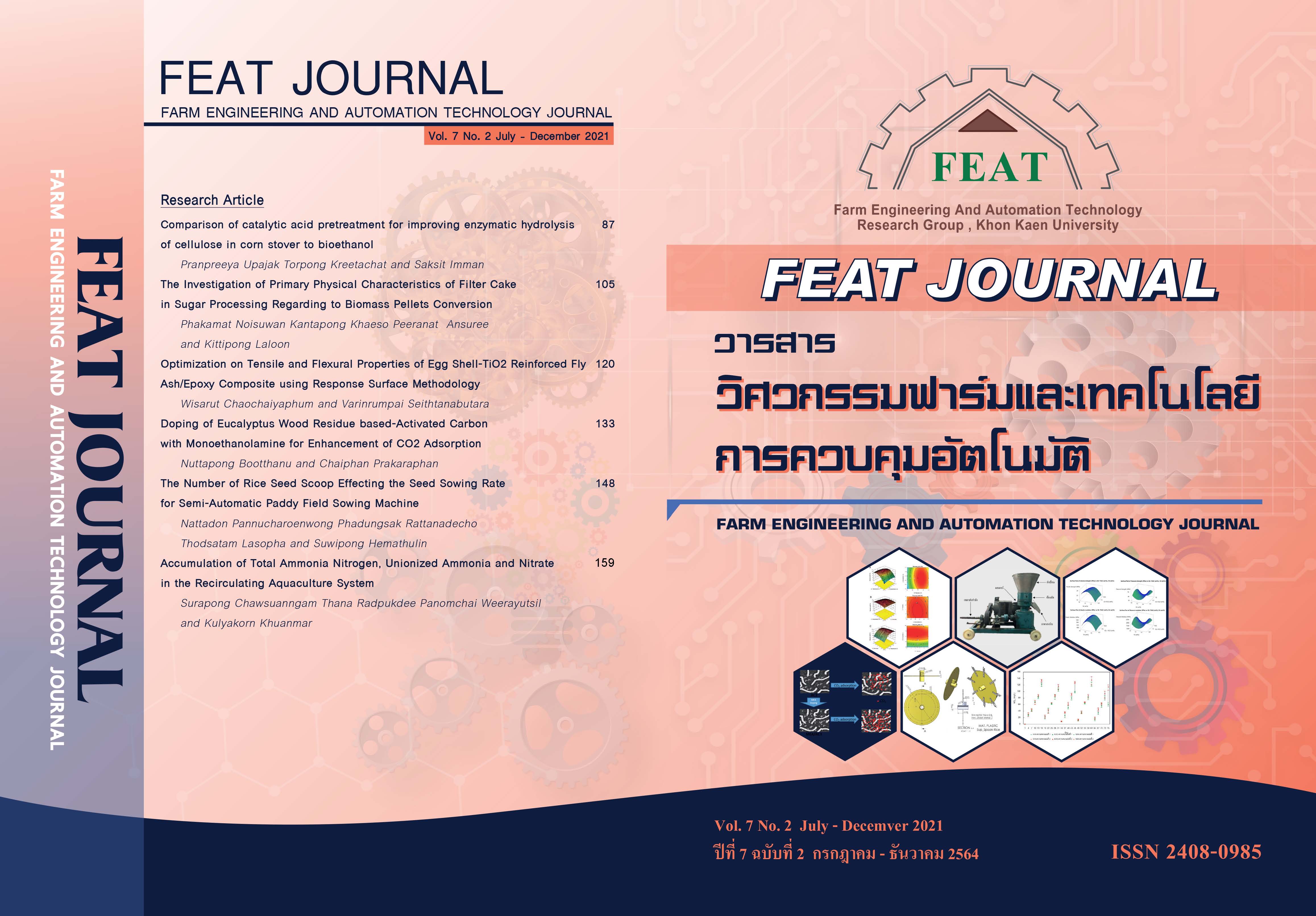การเปรียบเทียบตัวเร่งปฏิกิริยากรดในการปรับสภาพต้นข้าวโพด เพื่อพัฒนาการย่อยเซลลูโลสโดยเอนไซม์ ในการผลิตไบโอเอทานอล
Main Article Content
บทคัดย่อ
งานวิจัยนี้ศึกษาตัวเร่งปฏิกิริยากรดที่แตกต่างกัน ได้แก่ กรดซัลฟูริก กรดฟอสฟอริก และกรดฟอร์มิก หาสภาวะที่เหมาะสมของตัวเร่งปฏิกิริยากรดในการปรับสภาพต้นข้าวโพด เพื่อเพิ่มประสิทธิภาพการย่อยด้วยเอนไซม์ สู่การผลิตไบโอเอทานอล ด้วยวิธีออกแบบการทดลองแบบพื้นผิวตอบสนอง (Response Surface Methodology, RSM) โดยโปรแกรม Design-Expert 10.0.1 วางแผนการทดลองด้วยวิธี Central Composite ซึ่งประกอบด้วยปัจจัยหลัก 3 ปัจจัย ได้แก่ ความเข้มข้นกรด (0.05, 0.1 และ 0.15 โมลาร์) เวลาในการทำปฏิกิริยา (15, 30 และ 45 นาที) และอุณหภูมิ (90, 120, 150, 180 และ 210 องศาเซลเซียส) หลังจากทำการปรับสภาพแล้วนำไปย่อยด้วยเอนไซม์ เพื่อศึกษาหาสภาวะที่เหมาะสมในการผลิตกลูโคส (Glucose yield) เพื่อการผลิตไบโอเอทานอล ผลการศึกษาพบว่าการปรับสภาพด้วยกรดซัลฟิวริก 0.1 โมลาร์ ที่อุณหภูมิ 180 องศาเซลเซียส ระยะเวลา 30 นาที เป็นสภาวะที่เหมาะสมในการปรับสภาพต้นข้าวโพด สภาวะที่เหมาะสมที่สุดนั้นมุ่งเน้นไปที่การผลิตน้ำตาลกลูโคสสูงสุดจากการย่อยด้วยเอนไซม์ และเกิดสารยับยั้งในของเหลวหลังจากปรับสภาพต่ำ สภาวะที่เหมาะสมแสดงให้เห็นว่าสามารถผลิตกลูโคส 91.34% จากการย่อยด้วยเอนไซม์ของต้นข้าวโพดและการละลายของเฮมิเซลลูโลส 99.39% เกิดสารยับยั้งในกระบวนการปรับสภาพต่ำ ต้นข้าวโพดหลังผ่านการปรับสภาพจะนำมาวิเคราะห์ทางกายภาพ ได้แก่ กล้องจุลทรรศน์อิเล็กตรอนแบบส่องกราด (SEM) XRD BET และ FTIR
Article Details
วารสารวิศวกรรมฟาร์มและเทคโนโลยีควบคุมอัตโนมัติ (FEAT Journal) มีกําหนดออกเป็นราย 6 เดือน คือ มกราคม - มิถุนายน และกรกฎาคม - ธันวาคม ของทุกปี จัดพิมพ์โดยกลุ่มวิจัยวิศวกรรมฟาร์มและเทคโนโลยีควบคุมอัตโนมัติ คณะวิศวกรรมศาสตร์มหาวิทยาลัยขอนแก่น เพื่อเป็นการส่งเสริมและเผยแพร่ความรู้ ผลงานทางวิชาการ งานวิจัยทางด้านวิศวกรรมศาสตร์และเทคโนโลยีพร้อมทั้งยังจัดส่ง เผยแพร่ตามสถาบันการศึกษาต่างๆ ในประเทศด้วย บทความที่ตีพิมพ์ลงในวารสาร FEAT ทุกบทความนั้นจะต้องผ่านความเห็นชอบจากผู้ทรงคุณวุฒิในสาขาที่เกี่ยวข้องและสงวนสิทธิ์ ตาม พ.ร.บ. ลิขสิทธิ์ พ.ศ. 2535
References
Annual report 2018; 2018 [cites 2020 June 20]. Available from: http://investor.impact
growthreit.com/misc/ar/20180620-impact-ar-2018-en-03.pdf.
Limayem A, Ricke SC. Lignocellulosic biomass for bioethanol production: current perspectives, potential issues and future prospects. Progress in Energy and Combustion Science. 2012; 38(4): 449-67.
Sluiter A, Hames B, Ruiz R, Scarlata C, Sluiter J, Templeton D, Crocker D. Determination of structural carbohydrates and lignin in biomass. Laboratory Analytical Procedure. 2008; 1617: 1-16.
Sindhu R, Kuttiraja M, Binod P, Sukumaran RK, Pandey A. Physicochemical characterization of alkali pretreated sugarcane tops and optimization of enzymatic saccharification using response surface methodology. Renewable Energy 2014; 62: 362-8.
Sluiter A, Hames B, Ruiz R, Scarlata C, Sluiter J, Templeton D. Determination of sugars, byproducts, and degradation products in liquid fraction process samples. Golden. National Renewable Energy Laboratory. 2006.
Li C, Knierim B, Manisseri C, Arora R, Scheller HV, Aue, M, Vogel KP, Simmons BA, Singh S. Comparison of dilute acid and ionic liquid pretreatment of switchgrass: biomass recalcitrance, delignification and enzymatic saccharification. Bioresource technology. 2010; 101(13): 4900-6.
Shahabazuddin M, Chandra TS, Meena S, Sukumaran R, Shetty N, Mudliar S. Thermal assisted alkaline pretreatment of rice husk for enhanced biomass deconstruction and enzymatic saccharification: Physico-chemical and structural characterization. Bioresource technology. 2018; 263: 199-206.
Lu X, Zhang Y, Angelidaki I. Optimization of H2SO4-catalyzed hydrothermal pretreatment of rapeseed straw for bioconversion to ethanol: focusing on pretreatment at high solids content. Bioresource technology. 2009; 100(12): 3048-53.
Zhao X, Wang L, Lu X, Zhang S. Pretreatment of corn stover with diluted acetic acid for enhancement of acidogenic fermentation. Bioresource technology. 2014; 158: 12-8.
Alvira P, Tomás-Pejó E, Ballesteros M, Negro MJ. Pretreatment technologies for an efficient bioethanol production process based on enzymatic hydrolysis: A review. Bioresource Technology. 2010; 101(13), 4851-61.
Suriyachai N, Champreda V, Kraikul N, Techanan W, Laosiripojana N. Fractionation of lignocellulosic biopolymers from sugarcane bagasse using formic acid-catalyzed organosolv process. 3 Biotech. 2018; 8(5): 221.
Schneider L, Dong Y, Haverinen J, Jaakkola M, Lassi U. Efficiency of acetic acid and formic acid as a catalyst in catalytical and mechanocatalytical pretreatment of barley straw. Biomass and Bioenergy. 2016; 91: 134-42.
Wu W, Rondon V, Weeks K, Pullammanappallil P, Ingram LO, Shanmugam K. Phosphoric acid based pretreatment of switchgrass and fermentation of entire slurry to ethanol using a simplified process. Bioresource technology. 2018; 251: 171-80.
Bao W, Binder T, Abbas C, Loveless L. C1-C2 organic acid treatment of lignocellulosic biomass to produce acylated cellulose pulp, hemicellulose, lignin and sugars and fermentation of the sugars. In. Google Patents, 2014
Ge L, Wang P, Mou H. Study on saccharification techniques of seaweed wastes for the transformation of ethanol. Renewable energy. 2011; 36(1): 84-9.
Li J, Zhang R, Siddhu MAH, He Y, Wang W, Li Y, Chen C, Liu G. Enhancing methane production of corn stover through a novel way: sequent pretreatment of potassium hydroxide and steam explosion. Bioresource Technology. 2015; 181: 345-50.
Li C, Cheng G, Balan V, Kent MS, Ong M, Chundawat SP, daCosta Sousa L, Melnichenko YB, Dale BE, Simmons BA. Influence of physico-chemical changes on enzymatic digestibility of ionic liquid and AFEX pretreated corn stover. Bioresource technology 2011; 102(13): 6928-36.
Mood SH, Golfeshan AH, Tabatabaei M, Abbasalizadeh S, Ardjmand M, Jouzani GS. Comparison of different ionic liquids pretreatment for corn stover enzymatic saccharification. Preparative Biochemistry and Biotechnology. 2014; 44(5): 451-63.
Imman S, Laosiripojana N, Champreda V. Effects of liquid hot water pretreatment on enzymatic hydrolysis and physicochemical changes of corncobs. Applied biochemistry and biotechnology. 2018; 184(2): 432-43.
Zhang P, Dong SJ, Ma HH, Zhang BX, Wang YF, Hu XM. Fractionation of corn stover into cellulose, hemicellulose and lignin using a series of ionic liquids. Industrial Crops and Products. 2015; 76: 688-96.
Guo J, Catchmark JM. Surface area and porosity of acid hydrolyzed cellulose nanowhiskers and cellulose produced by Gluconacetobacter xylinus. Carbohydrate polymers. 2012; 87(2): 1026-37.
Tan IS, Lee KT. Solid acid catalysts pretreatment and enzymatic hydrolysis of macroalgae cellulosic residue for the production of bioethanol. Carbohydrate Polymers. 2015; 124: 311-21.
Bai F, Anderson W, Moo-Young M. Ethanol fermentation technologies from sugar and starch feedstocks. Biotechnology advances. 2008; 26(1): 89-105.
Weerasai K, Suriyachai N, Poonsrisawat, A, Arnthong J, Unrean P, Laosiripojana N, Champreda V. Sequential acid and alkaline pretreatment of rice straw for bioethanol fermentation. BioResources. 2014; 9(4): 5988-6001.
Öhgren K, Bura R, Lesnicki G, Saddler J, Zacchi G. A comparison between simultaneous saccharification and fermentation and separate hydrolysis and fermentation using steam-pretreated corn stover. Process Biochemistry. 2007; 42(5): 834-9.

